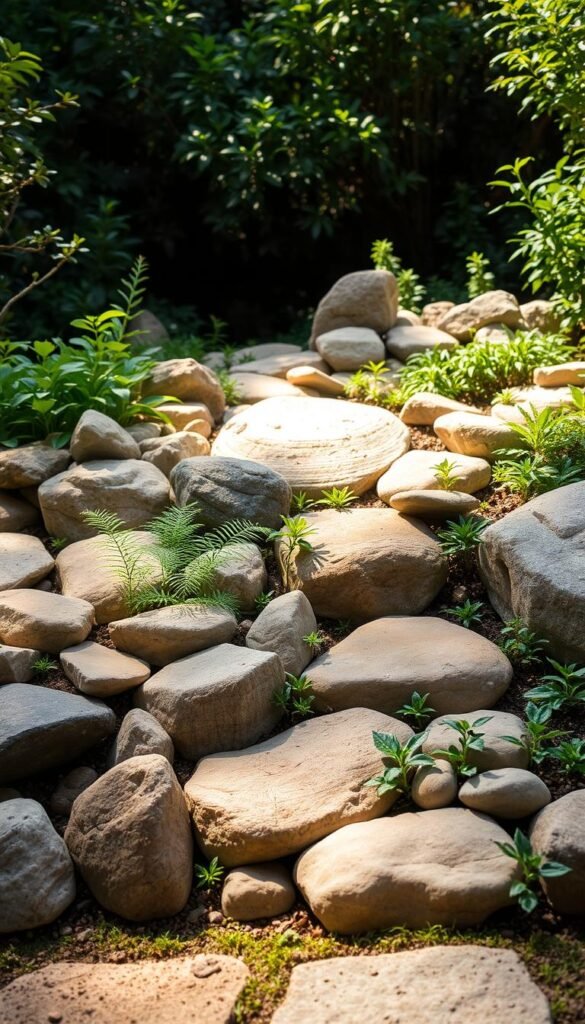Imagine turning tricky spots in your yard into eye-catching displays that thrive with little effort. Stone arrangements paired with drought-tolerant plants create dynamic outdoor areas that work year-round. These designs add depth to flat spaces and turn slopes into artistic features instead of maintenance headaches.
What makes these layouts stand out? They blend practicality with raw beauty. You can tackle poor drainage zones or replace high-maintenance grass with layered textures that mirror natural landscapes. Many homeowners find they’re perfect for corners where nothing else grows, requiring just seasonal tidying.
Want to bridge your home’s style with the surrounding environment? Check out our guide to elevating your gardening aesthetic for complementary strategies. From gravel pathways to boulder clusters, these elements establish structure while supporting local ecosystems.
You’ll soon discover how varying stone sizes and strategic plant placement create visual movement. Smaller pebbles contrast beautifully with rugged rocks, while creeping groundcovers soften edges. This approach adapts to any space – whether crafting a minimalist courtyard feature or reimagining an entire hillside.
Designing Your Rock Garden Space
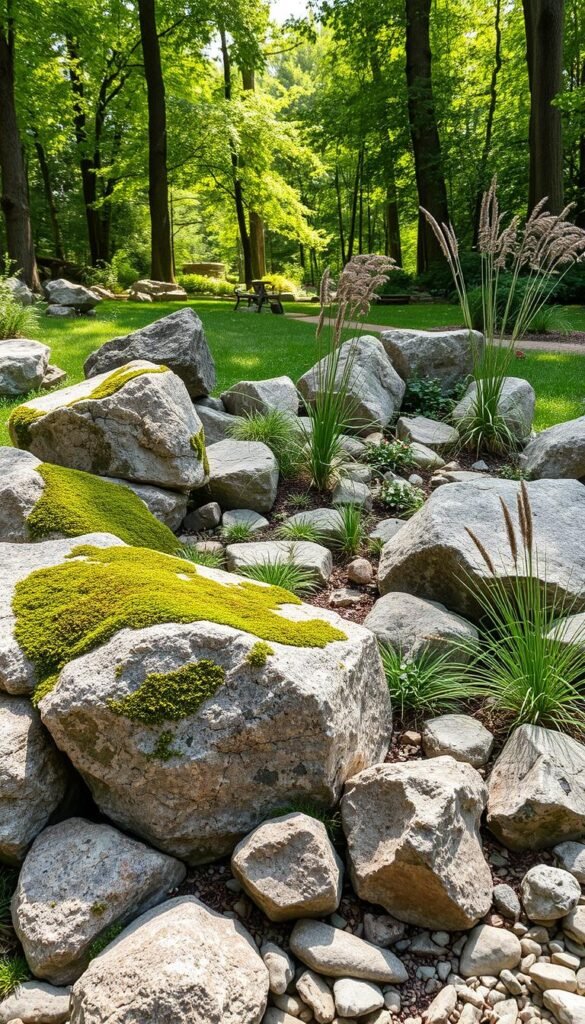
Creating a rock garden begins with understanding your space’s potential. You’ll want to map out sun patterns and water flow before placing your first stone. This approach ensures your layout works with nature, not against it.
Smart Site Evaluation Tactics
Start by tracking sunlight across your yard for 2-3 days. Note where water pools after rain and areas with rocky soil. These observations help identify prime spots for drought-loving plants and stable rock placements.
| Site Factor | Sunny Areas | Shaded Zones |
|---|---|---|
| Best Plants | Sedum, Lavender | Ferns, Moss |
| Rock Types | Light-colored stones | Mossy boulders |
| Drainage Needs | Fast-draining gravel | Moisture-retentive soil |
Effortless Maintenance Solutions
Choose plants that thrive in your local climate to reduce watering. Group rocks by size for visual flow – larger stones anchor corners, while gravel fills gaps. A 4-inch layer of crushed granite beneath features prevents weeds naturally.
Sketch your ideas using grid paper or free apps like iScape. For complex slopes, consult a landscape pro – they’ll spot drainage issues you might miss. Remember: good planning today means less work tomorrow.
Inspiring Rock Garden Ideas for a Textured Natural Look
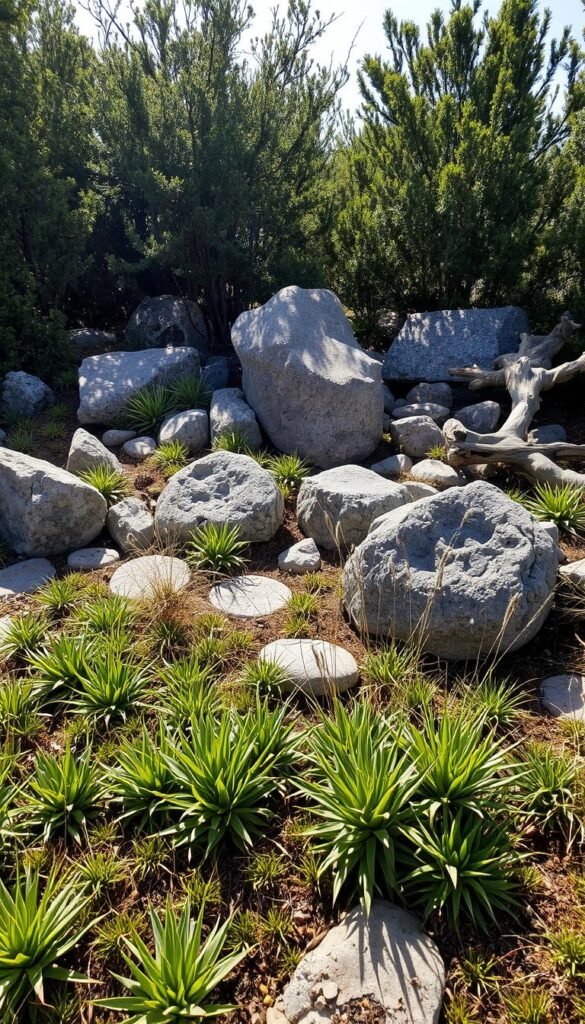
Unlock your yard’s potential with creative stone arrangements that blend rugged materials and lush greenery. Whether you’re working with sprawling slopes or compact corners, these layouts thrive through clever layering and strategic plant pairings. Even containers can host miniature landscapes using pebbles and alpine succulents for year-round appeal.
Start by mixing stone sizes to create depth. Large boulders anchor spaces, while gravel fills gaps with effortless charm. Try pairing smooth river rocks with spiky ornamental grasses for contrast. This approach mimics wild terrain while keeping maintenance minimal – perfect for busy homeowners.
Don’t overlook vertical surfaces. Stack flat stones into retaining walls or craft cascading steps that double as pathways. These features guide movement through your space while adding architectural interest. Tuck drought-resistant shrubs between cracks to soften edges and attract pollinators.
For patios or balconies, arrange smaller pebbles in shallow pots with creeping thyme or sedum. These mobile displays prove you don’t need vast areas to enjoy a layered look. Combine slate chips with moss-covered stones for tactile variety that feels intentional yet organic.
Incorporating Varied Rocks and Materials
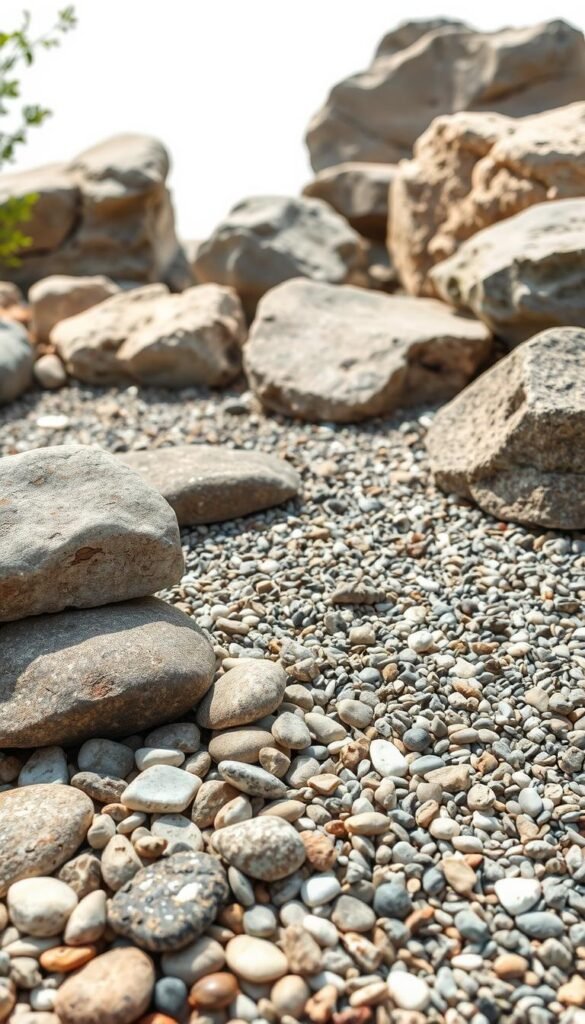
Your stone choices make or break your landscape’s character. Start by matching materials to your home’s proportions – a cottage needs different elements than a modern ranch. Think of stones as your garden’s backbone, creating structure while letting plants shine.
Selecting the Perfect Stones and Boulders
Scale matters most. Use car-sized boulders only in spacious yards, while fist-sized rocks work better in compact areas. For homes with clean lines, try angular slate. Cozy cottages pair well with rounded river stones. Always source local materials when possible – they blend naturally with your region’s terrain.
Balancing Colors and Textures for Visual Impact
Light-colored stones prevent dark, heavy feels. Pair warm tans with cool grays for contrast that pops. Mix textures strategically: jagged granite beside smooth pebbles adds drama without chaos. Remember – three material types max per zone keeps designs cohesive.
Group similar stones together like puzzle pieces. A gravel bed framed by larger rocks creates flow, while stepping stones guide foot traffic. For homes blending old and new elements, explore our guide to timeless garden designs. This approach ensures every stone serves both form and function.
Integrating Plants That Complement Your Rocks
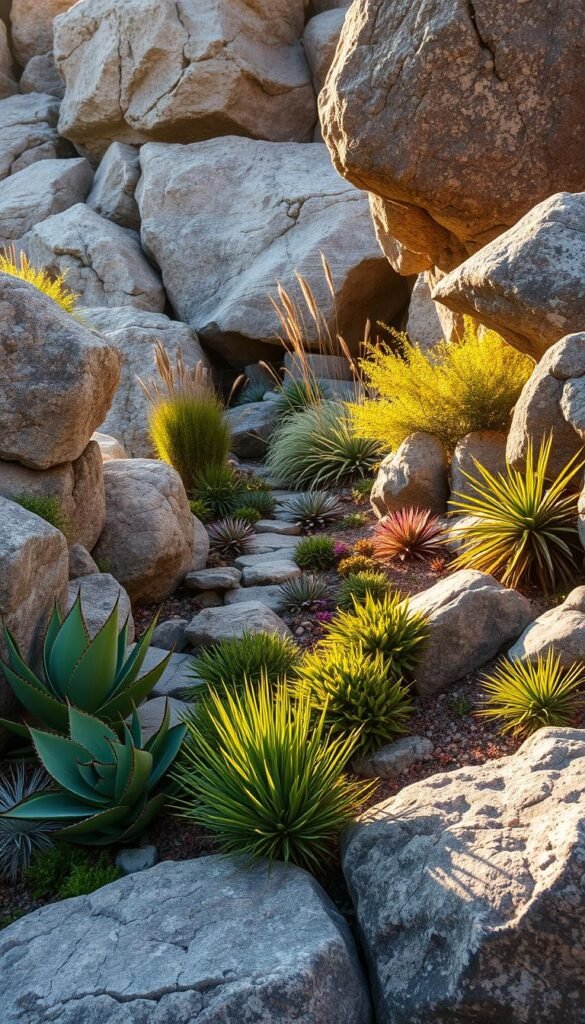
What transforms a collection of stones into a living landscape? The right plants breathe life into rocky spaces while enhancing their rugged charm. Start by matching greenery to your local climate and the unique microclimates created by stone placements.
Choosing Drought-Tolerant and Alpine Varieties
Alpine plants thrive where others struggle. These mountain natives love sharp drainage and lean soil – conditions your stone features naturally provide. Try sedums that store water in fleshy leaves or creeping thyme that releases fragrance when brushed. For shaded crevices, mosses and ajuga spread like living carpets.
Pairing Foliage and Floral Accents
Create contrast with spiky blue fescue grass beside smooth river rocks. Add pops of color with ice plant’s daisy-like blooms or golden alyssum’s sunny clusters. “The best combinations play with texture first, then introduce seasonal color,” suggests a Colorado landscaper. Evergreen shrubs like dwarf conifers maintain structure when flowers fade.
Arrange taller perennials like yarrow or lavender behind ground-hugging varieties. This layering mimics how plants grow in wild stony areas. Let trailing species spill over rocks – snow-in-summer’s white flowers softening edges in spring, while sedum’s autumn hues echo falling leaves.
Utilizing Water Features and Zen Elements
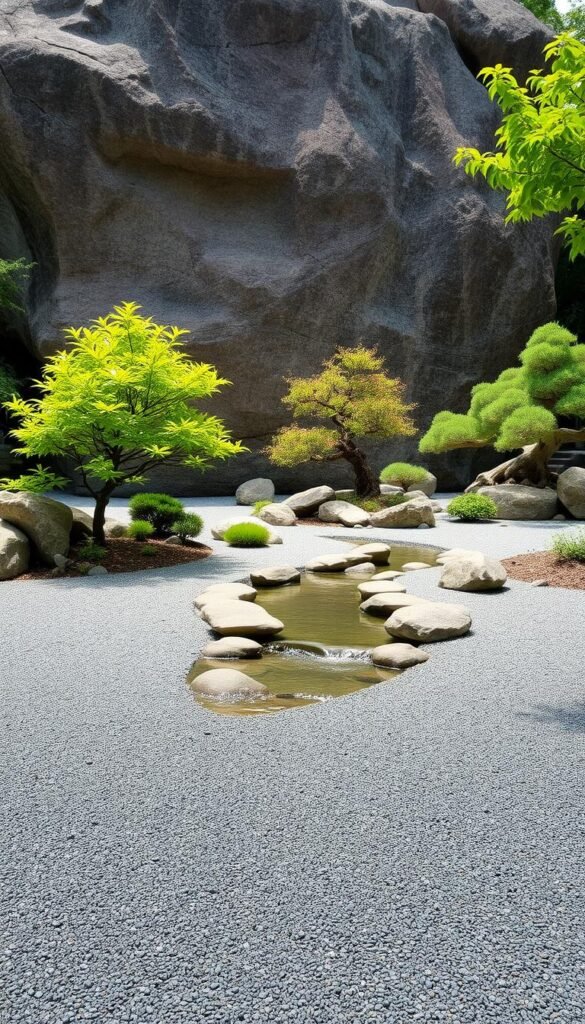
Transform your outdoor space into a peaceful retreat by blending flowing water features with minimalist zen garden principles. These elements add movement and meditation spots to stone landscapes while keeping maintenance low.
Creating a Soothing Waterfall or Pond
Build natural-looking cascades by stacking flat stones at gradual angles. Use mossy boulders to hide pumps and tubing. “The secret lies in mimicking how water carves through stone over centuries,” notes a Colorado landscape designer.
| Feature Type | Best Materials | Maintenance Level |
|---|---|---|
| Pond | Flexible liner + river rocks | Monthly cleaning |
| Waterfall | Sandstone slabs + pump | Seasonal adjustments |
| Bubbling Urn | Ceramic pot + recirculating pump | Weekly checks |
Designing a Tranquil Zen Garden
Rake white sand into wave patterns around angular stones. Choose three focal boulders to represent earth elements. This zen approach works well in small spaces – even a 4x4ft area creates calm.
“Raking sand focuses the mind like meditation. Each stroke becomes a breathing exercise.”
Add a stone basin for water sounds without complex plumbing. Surround it with crushed granite that stays cool underfoot. These features prove serenity doesn’t require constant upkeep.
Natural and Artistic Rock Arrangements
Discover how strategic placements can create landscapes that feel untouched by time. The secret lies in replicating nature’s chaotic harmony – where stones appear settled by wind and weather rather than human planning.
Crafting Organic Groupings of Stones
Begin with your largest stones as anchors. Position these first to mimic how rocks emerge from terrain naturally. Tilt them slightly and bury edges to suggest they’ve rested there for centuries.
| Arrangement Technique | Purpose | Example |
|---|---|---|
| Focal Points | Create visual anchors | 3 boulders forming triangle |
| Odd Number Groupings | Enhance natural feel | 5 stones in staggered heights |
| Varied Heights | Add depth | Flat slate beside upright column |
| Plant Spaces | Ensure growth areas | 12″ gaps between clusters |
| 360° Views | Maintain appeal | Check from patio and path |
Work in odd numbers – three or five stones per cluster – to avoid rigid symmetry. Vary their shape and orientation as you build outward from primary anchors. Leave elbow room between groupings for creeping phlox or sedum to sprawl.
Step back frequently during placement. Walk around your design to ensure it looks balanced from all angles. “The best arrangements trick the eye into seeing geological history,” notes a Utah landscape architect. Use smaller pebbles to connect clusters like nature’s mortar.
Finish by scattering gravel around your main features. This final layer unifies the space while suppressing weeds. Your creation will feel like it’s always belonged there – rugged, raw, and perfectly imperfect.
DIY Rock Garden Ideas for the Weekend
Revamp your outdoor space in just two days with these achievable stone projects. Weekend warriors can craft striking features using basic materials and clever layouts – no heavy machinery required.
Quick Projects to Transform Your Yard
Build a raised bed in 4 hours using flat stones and wire mesh. Stack materials like building blocks, securing layers with landscape spikes. This time-saving method creates instant elevation for drainage-loving succulents.
Upgrade walkways by scattering gravel over existing paths. Use edging stones to contain the spread – it’s faster than removing grass. For sparkle, mix crushed glass with pea gravel near seating areas.
| Project | Materials | Time Needed |
|---|---|---|
| Mini Zen Garden | Sand, 3 stones | 90 minutes |
| Rock Border | Fieldstones, shovel | 3 hours |
| Container Feature | Old pot, lava rocks | 45 minutes |
Salvage materials from demolition sites or construction leftovers. Many suppliers offer discounted “seconds” – slightly imperfect stones that add character. Focus on one focal piece per zone to maximize impact without clutter.
These projects prove you don’t need special skills to create eye-catching designs. Start small, learn as you go, and watch your confidence grow with each stone placed.
Rock Garden Ideas That Enhance Curb Appeal
Your home’s first impression begins at the street. Thoughtful stone arrangements turn bland front yards into welcoming spaces that balance beauty and function. These designs solve common landscaping headaches while adding personality to your property’s entrance.
Front Yard Inspirations and Design Tips
Custom-engraved stones make practical art. Carve your house number into a flat boulder near the driveway – it’s easier to spot than traditional signage. “Address rocks double as wayfinders and conversation starters,” says a Texas landscaper. Pair them with drought-resistant sedum for year-round color.
Use broad, flat stones as natural benches beside entryways. They create seating without bulky furniture. For tricky curb strips between sidewalk and street, replace thirsty grass with gravel and creeping thyme. This combo withstands foot traffic while staying green.
| Path Material | Best Use | Maintenance |
|---|---|---|
| Flagstone | Formal entries | Annual re-leveling |
| Crushed granite | Casual walkways | Biweekly raking |
| Stepping stones | Grassy areas | Monthly edging |
Crafting Unique Stone Pathways
Guide visitors naturally with winding paths. Alternate large stepping stones with groundcover plants like blue star creeper. For modern homes, try geometric patterns using slate tiles. Leave 1-inch gaps between stones for moss or dwarf mondo grass to soften edges.
Edge pathways with smaller rocks to prevent gravel spread. Use contrasting colors – light limestone against dark mulch creates crisp lines. These features work double duty, directing rainwater away from foundations while boosting visual flow.
Rock Garden Designs for Different Landscapes
Every terrain offers unique opportunities to showcase stones and plants in harmony. Whether your yard slopes steeply or lies perfectly flat, strategic designs maximize both beauty and function. Start by observing how water moves through your space and which areas get full sun versus shade.
Adapting to Sloped Terrains
Steep inclines become assets with staggered boulders that prevent erosion. Bury each stone up to one-third its height, tilting slightly backward for stability. Native grasses like blue fescue thrive between rocks, while junipers cascade down hillsides. Retaining walls built from local stone create terraced planting pockets perfect for alpine species.
In rainy regions, use angular rocks to direct runoff away from foundations. Space stones loosely to let groundcovers like creeping phlox knit everything together. This approach mimics natural mountainscapes while controlling soil movement.
Enhancing Flat Areas
Flat yards gain depth through elevation tricks. Build raised mounds using rubble as a base, then cap with decorative stones. Cluster vertical rocks as focal points, surrounding them with low-growing sedum or hens-and-chicks. For cohesion, stick to one stone type in mixed sizes – a principle highlighted in expert rock garden designs.
Create winding gravel paths between features to add movement. Use moss-filled crevices between stones for unexpected softness. These techniques transform level ground into dynamic spaces that feel organically layered, proving even simple layouts can captivate.

